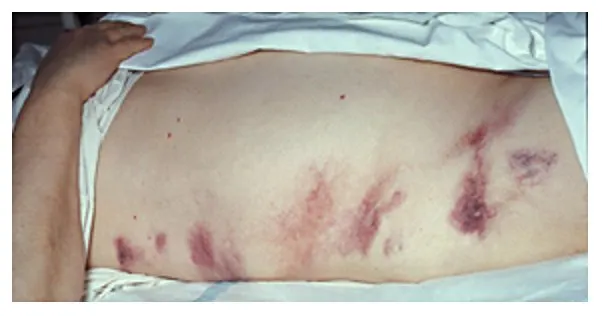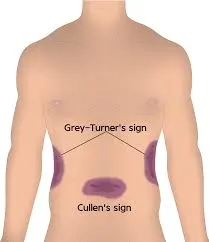What is Grey Turner's sign?
When a peculiar bruise-like discoloration appears on the sides of your abdomen, it might be more than just a simple injury. This distinctive marking, known as Grey Turner's Sign, serves as a visible warning that something significant could be happening inside your body.

What Makes It Different?
Unlike typical bruises from bumps or falls, Grey Turner's Sign appears without direct injury to the area. Named after British surgeon George Grey Turner who first described it in 1920, this sign has become an important clinical indicator that healthcare providers take very seriously.
Comparing Grey Turner's Sign and Cullen's Sign
While Grey Turner's Sign appears on the flanks, it's often mentioned alongside its "cousin" - Cullen's Sign. Understanding the differences and similarities can help you better recognize these important warning signs:
| Feature | Grey Turner's Sign | Cullen's Sign |
|---|---|---|
| Location | Flanks/sides of abdomen | Around the navel |
| Timing | 24-48 hours after onset | 24-72 hours after onset |
| Color | Bluish-purple to brown | Bluish-purple to green |
| Common Causes | Acute pancreatitis, retroperitoneal bleeding | Acute pancreatitis, ectopic pregnancy |
| Significance | ~40% mortality when present | ~30% mortality when present |

When Both Signs Appear
Sometimes, both signs may appear together, which often indicates:
- More severe underlying condition
- Greater extent of internal bleeding
- Higher risk of complications
- Need for more aggressive treatment
Healthcare providers take the presence of either sign seriously, but when both appear together, it usually signals a need for immediate intensive care. Both signs help doctors understand:
- The severity of the condition
- The spread of internal bleeding
- Potential complications
- Treatment urgency
The Science Behind the Sign
Imagine your body as a complex building with multiple floors. When something goes wrong on the upper floors (inside your body), the evidence slowly seeps down through the levels until it becomes visible on the surface (your skin). This process typically takes 24-48 hours, which explains why the sign doesn't appear immediately after an internal problem begins.
Key Visual Characteristics:
- Bluish-purple to brownish-yellow coloring
- Appears on both sides of the abdomen
- Often feels slightly firm to touch
- Develops gradually over 1-2 days
- Covers larger areas than typical bruises
Common Causes and Their Features
| Condition | Frequency | Mortality Rate | Typical Duration |
|---|---|---|---|
| Acute Pancreatitis | 65% | 15-20% | 5-10 days |
| Internal Hemorrhage | 20% | 30-40% | Variable |
| Abdominal Trauma | 10% | 25-35% | 2-4 weeks |
| Cancer-related | 5% | Varies | Chronic |
When to Seek Immediate Medical Care
Don't wait if you notice these warning signs:
- Sudden flank discoloration
- Severe abdominal pain
- Persistent vomiting
- High fever (above 101°F/38.3°C)
- Mental confusion
- Difficulty breathing
Diagnostic Journey
| Test Type | Purpose | Timing |
|---|---|---|
| Physical Exam | Initial assessment | Immediate |
| Blood Tests | Organ function, inflammation | Within 1-2 hours |
| CT Scan | Internal bleeding, inflammation | Within 4-6 hours |
| MRI | Detailed tissue examination | If needed, 24-48 hours |
While Grey Turner's Sign itself is visible on physical examination, imaging studies play a crucial role in identifying the underlying cause. Modern tools like X-ray Interpreter help healthcare providers analyze these medical images more effectively, ensuring accurate diagnosis of conditions such as pancreatitis or internal bleeding that might be causing the sign.
The Recovery Process
Your healing journey will be unique, but typically includes these phases:
Early Hospital Phase:
- Continuous monitoring of vital signs
- Pain management
- Fluid replacement therapy
- Treatment of underlying condition
- Regular blood tests
Middle Recovery Phase:
- Gradual return to eating
- Physical activity as tolerated
- Medication adjustments
- Ongoing monitoring
Long-term Recovery:
- Regular follow-up appointments
- Lifestyle modifications
- Prevention strategies
- Monitoring for recurrence
Prevention Strategies
| Risk Factor | Prevention Strategy | Effectiveness |
|---|---|---|
| Alcohol Use | Complete cessation | High |
| Diet | Low-fat, balanced meals | Moderate |
| Medications | Regular review | Moderate |
| Lifestyle | Regular exercise, weight control | Moderate |
Living with Recovery
Your recovery success depends on several factors:
- Following medical advice closely
- Attending all follow-up appointments
- Making recommended lifestyle changes
- Monitoring for any new symptoms
- Maintaining good communication with your healthcare team
Important Monitoring Signs:
- Pain levels
- Energy levels
- Appetite changes
- Skin color changes
- New symptoms
Frequently Asked Questions
What is the Grey Turner sign of the kidneys?
Grey Turner's Sign can appear in kidney conditions, particularly when there's bleeding around the kidneys (perirenal hemorrhage). While it's more commonly associated with pancreatic problems, kidney conditions that may cause this sign include:
- Severe kidney infections
- Kidney trauma
- Bleeding complications from kidney procedures
- Ruptured kidney tumors
The sign appears in kidney conditions because the kidneys are located in the retroperitoneal space - the same anatomical area where pancreatic inflammation can cause bleeding. When blood from kidney problems tracks through this space, it creates the characteristic flank discoloration.
What is Grey Turner and Cullen sign pathophysiology?
The pathophysiology (the way these signs develop) involves a fascinating process of fluid movement through tissue planes:
- Initial Event:
- Internal bleeding or inflammation occurs in deep tissues
- Usually starts in the retroperitoneal space (behind the abdominal cavity)
- Fluid Movement:
- Blood or inflammatory fluid follows paths of least resistance
- Travels along fascial planes (natural tissue boundaries)
- Sign Development: For Grey Turner's Sign:
- Fluid travels along the posterior pararenal space
- Moves through lateral fascial planes
- Eventually reaches subcutaneous tissues in the flanks
For Cullen's Sign:
- Fluid travels along the falciform ligament
- Moves through anterior abdominal wall
- Reaches subcutaneous tissues around the umbilicus
| Stage | Timeline | Process |
|---|---|---|
| Early | 0-12 hours | Internal bleeding/inflammation begins |
| Intermediate | 12-24 hours | Fluid travels through tissue planes |
| Visible | 24-48 hours | Discoloration appears on skin |
| Peak | 2-4 days | Maximum visibility of signs |
This understanding of the pathophysiology helps doctors:
- Predict the severity of the underlying condition
- Estimate the timing of the initial injury
- Plan appropriate treatment strategies
- Monitor disease progression
Support and Resources
Recovery can be challenging, but you're not alone:
- Join support groups
- Connect with others who've had similar experiences
- Work closely with your healthcare team
- Learn about your condition • Keep a symptom diary
Remember: Grey Turner's Sign is never normal and always requires medical attention. While it might be alarming to discover this sign, modern medicine offers excellent treatment options for the underlying causes. Your prompt action in seeking medical care can make a significant difference in your outcome.
Stay informed, stay vigilant, and remember that your healthcare team is there to help you through every step of your diagnosis and recovery journey.